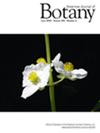Primroses famously employ a system that simultaneously expresses distyly and filters out self-pollen. Other species in the Primulaceae family, including Lysimachia monelli (blue pimpernel), also express self-incompatibility (SI), but involving a system with distinct features and an unknown molecular genetic basis.
We utilize a candidate-based transcriptome sequencing (RNA-seq) approach, relying on candidate T2/S-RNase Class III and S-linked F-box-motif-containing genes and harnessing the unusual evolutionary and genetic features of SI, to examine whether an RNase-based mechanism underlies SI in L. monelli. We term this approach "SI detection with RNA-seq" (SIDR).
The results of sequencing, crossing, population genetics, and molecular evolutionary features each support a causal association linking the recovered genotypes with SI phenotypes. The finding of RNase-based SI in Primulaceae (Ericales) all but cements the long-held view that this mechanism was present in the ancestral pentapetal eudicot, whose descendants now comprise two-thirds of angiosperms. It also significantly narrows the plausible maximum age for the heterostyly evolution within the family.
SIDR is powerful, flexible, inexpensive, and most critically enables work in often-neglected species. It may be used with or without candidate genes to close enormous gaps in understanding the genetic basis of SI and the history of breeding system evolution.



